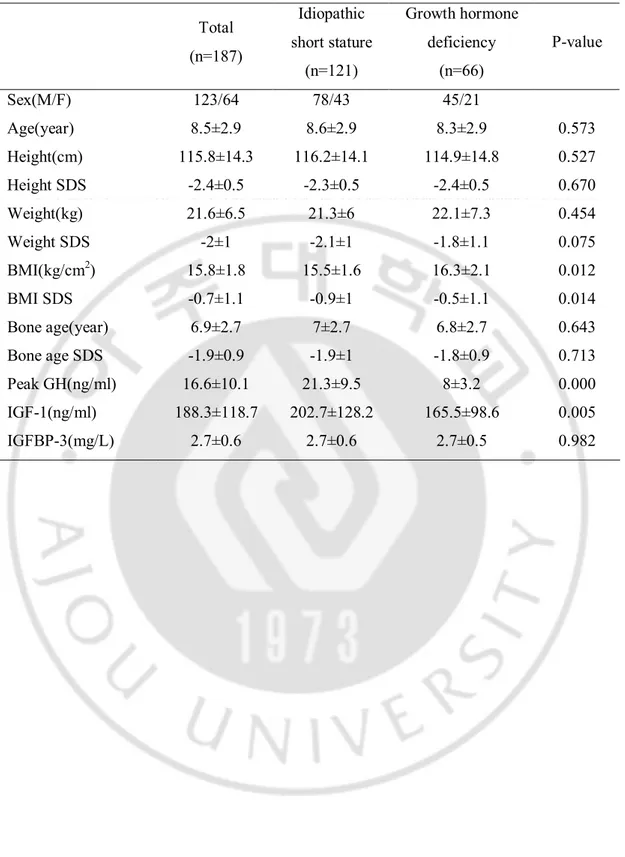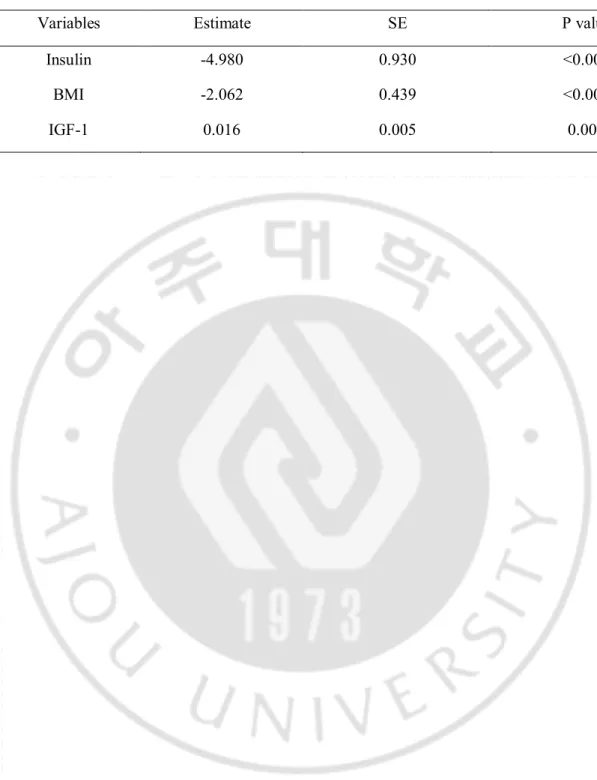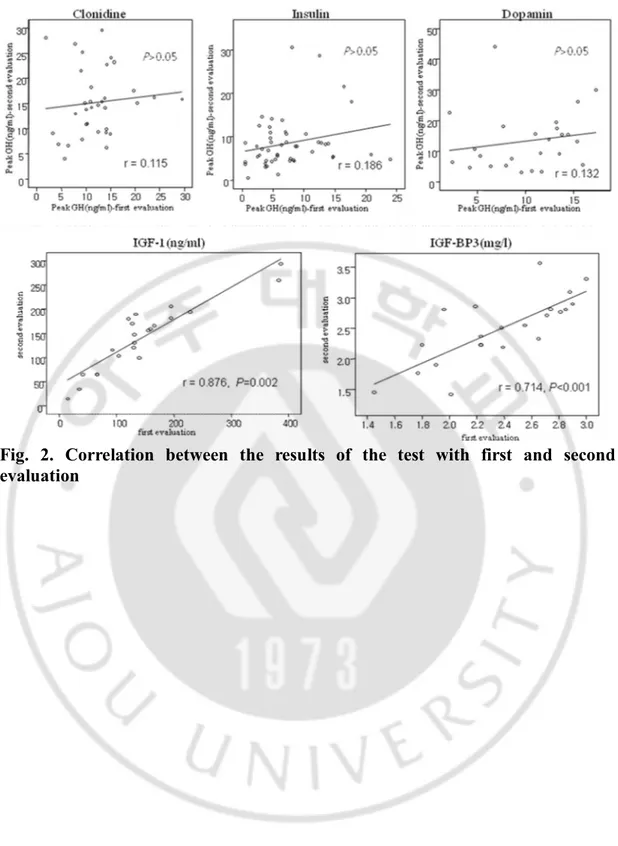저작자표시-비영리-변경금지 2.0 대한민국 이용자는 아래의 조건을 따르는 경우에 한하여 자유롭게 l 이 저작물을 복제, 배포, 전송, 전시, 공연 및 방송할 수 있습니다. 다음과 같은 조건을 따라야 합니다: l 귀하는, 이 저작물의 재이용이나 배포의 경우, 이 저작물에 적용된 이용허락조건 을 명확하게 나타내어야 합니다. l 저작권자로부터 별도의 허가를 받으면 이러한 조건들은 적용되지 않습니다. 저작권법에 따른 이용자의 권리는 위의 내용에 의하여 영향을 받지 않습니다. 이것은 이용허락규약(Legal Code)을 이해하기 쉽게 요약한 것입니다. Disclaimer 저작자표시. 귀하는 원저작자를 표시하여야 합니다. 비영리. 귀하는 이 저작물을 영리 목적으로 이용할 수 없습니다. 변경금지. 귀하는 이 저작물을 개작, 변형 또는 가공할 수 없습니다.
i
Influence of Body Mass Index on Growth Hormone
Responses to Classic Provocative Tests in Children
with Short Stature
by
Hae Sang Lee
Major in Medicine
Department of Medical Sciences
The Graduate School, Ajou University
ii
Influence of Body Mass Index on Growth Hormone Responses to
Classic Provocative Tests in Children with Short Stature
by
Hae Sang Lee
A Dissertation Submitted to The Graduate School of
Ajou University in Partial Fulfillment of the Requirements for
The Degree of
Master of Medicine
Supervised by
Jin Soon Hwang, M.D., Ph.D.
Major in Medicine
Department of Medical Sciences
The Graduate School, Ajou University
iii
This certifies that the dissertation
of Gill Dong Hong is approved.
SUPERVISORY COMMITTEE
Jin Soon Hwang
Ki Soo Pai
Jo Won Jung
The Graduate School, Ajou University
December, 23rd, 2010
iv
-Abstract-
Influence of Body Mass Index on Growth Hormone Responses to
Classic Provocative Tests in Children with Short Stature
Objective: Growth hormone (GH) secretion is regulated by physiological parameters. Obesity is associated with diminished spontaneous and stimulated GH secretion. The aim of this study was to assess the influence of BMI on growth hormone response to provocative testing in children with short stature.
Materials and methods: Clinical data was collected retrospectively by chart review from the Pediatric Endocrine Unit at Ajou University Hospital. A total of 187 subjects with short stature who completed a GH stimulation testing between 2003 and 2009 were included in the study.
Results: The study population included 123 (65.8%) males and 64 (34.2%) females with a mean age of 8.5 ± 2.9 years. Of the 187 subjects, 66 (35.3%) had GH deficiency (serum peak GH <10 ng/ml), while 121 (64.7%) were categorized as having idiopathic short stature (serum peak GH ≥ 10 ng/ml). In a stepwise multivariate analysis, BMI was a significantly independent predictor of peak GH. Elevated BMI was negatively associated with peak plasma GH levels.
Conclusion: Higher BMI is associated with lower GH secretion. BMI should be measured and GH results appropriately interpreted for all subject undergoing GH stimulation testing. Key words: Body mass index, Growth hormone, Short stature
v
TABLE OF CONTESTS
ABSTRACT---i TABLE OF CONTENTS---ii LIST OF FIGURES---iii LIST OF TABLES---iv I. INTRODUCTION---1II. MATERIALS AND METHODS---2
A. SUBJECTS---2 B. STUDY DESIGN---2 C. LABORATORY MEASUREMENTS---3 D. STATISTICAL ANALYSIS---4 III. RESULTS---5 A. SUBJECTS CHARACTERISTICS ---5
B. COMPARISON OF GH RESPONSES OF INSULIN VS. DOPAMINE AND CLONIDINE---5
C. DETERMINANTS OF PEAK GROWTH HORMONE RESPONSE TO PHARMACOLOGICAL TESTS---6 D. RELIABILITY OF TESTS---6 IV. DISCUSSION---12 V. CONCLUSION---15 REFERENCES---16 국문요약---21
vi
LIST OF FIGURES
Fig. 1. Mean peak GH responses to various provocative stimuli in all subjects---9 Fig. 2. Correlation between the results of the test with first and second evaluation---10
vii
LIST OF TABLES
Table 1. Clinical and laboratory characteristics of the subjects---6 Table 2. Multivariate analysis of factors associated with peak growth hormone values---7 Table 3. Peak growth hormone concentrations during the first and second test with clonidine,
א
I. INTRODUCTION
The diagnosis of growth hormone (GH) deficiency during childhood is classically based on the results of two stimulating tests performed using different stimuli. Growth hormone stimulation tests are burdened by methodological and interpretative limitations. The reliability of pharmacological tests used for GH secretion evaluation have been repeatedly questioned given the lack of normal age-related reference values, the use of different pharmacological stimuli and different laboratory methods for the measurement of circulating GH (Carel, et al., 1997;Hilczer, et al., 2006a;Mazzola, et al., 2008;Vestergaard, et al., 1997). Growth hormone secretion is regulated by multiple physiologic factors, including age, onset of puberty, nutritional status and body weight (Ho, et al., 1987;Iranmanesh, et al., 1991;Qu, et al., 2005). In adults, several reports have shown that obesity is associated with diminished spontaneous and stimulated GH secretion (Micmacher, et al., 2009;Qu, et al., 2005;Tzanela, et al., 2010;Van Dam, et al., 2002). There are only a few studies on GH response in obese children and adolescents (Misra, et al., 2008;Stanley, et al., 2009). Body mass index (BMI) is currently not considered a factor when determining current peak GH cut-off points used in the diagnosis of GH deficiency. We analyzed the effect of body mass index on the results of GH stimulation testing, studied the relative potencies of clonidine, insulin, and levodopa, as well as analyzed the reproducibility of growth hormone stimulation test in children with short stature.
ב
II. MATERIALS AND METHODS
A.Subjects
Clinical data was collected retrospectively by chart review from the Pediatric Endocrine Unit at Ajou University Hospital. A total of 187 pediatric patients with short stature who completed GH stimulation testing between 2003 and 2009 were included in the study. The patients’ heights were all less than -2 standard deviation (SD) below average, together with a decreased height velocity and delayed bone age. Study subjects underwent GH stimulation testing with a combination of at least two of the following: clonidine, L-dopa, insulin. Central nervous system neoplasm, multiple pituitary hormone deficiencies, and known Turner syndrome patients were excluded. Children receiving medications that may affect endogenous GH secretion, including oral or inhaled corticosteroids, antipsychotic medications, and ondansetron, were also excluded. GH deficiency patients had a GH peak <10 ng/ml on provocation with a combination of at least two separate stimulation trials (2000). Idiopathic short stature (ISS) was defined as a height less than -2 SD with a serum GH peak ≥ 10 ng/ml with stimulation.
B. Study design
After an overnight fast, an indwelling catheter was inserted into a cubital vein that was kept patent by slow saline infusion, and blood was sampled at the time of catheter insertion. All the stimulating tests were performed in the morning hours with one-day time interval
ג
between the two tests. Three different stimulation test protocols were used to assess GH secretion. Clonidin (150 μg/m2) and dopamine (Sinemet®, 10mg carbidopa/100mg levo-dopa,
150-175 mg/m2) was administered orally at time 0. Blood was drawn at the time of
administration of clonidine and dopamine to obtain the baseline GH values, and at 30, 60, 90, and 120 min thereafter. Insulin (0.1 IU/kg) was administered by an intravenous bolus at time 0 to induce a fall in the blood glucose level to 40 mg/dl or less Blood was drawn before testing (0 min) to obtain the baseline GH values and at 30, 60, 90, and 120 min after administration of the test. Experienced physicians or nurses were present throughout the procedure. From review of clinic charts and electronic medical records, height, weight, IGF-1, IGF-binding protein(IGFBP)-3, pubertal status, thyroid function, type of GH stimulation test, and peak GH levels after stimulation were collected. Pubertal status (Tanner stage for breast development [F] or genital development [M]) was assessed and documented by one pediatric endocrinologist. Bone age was measured using the method described by Greulich and Pyle (Greulich & Pyle, 1959). Body mass index was calculated, and BMI and height SD score were calculated using the 2007 Korean National Growth Charts (Moon, et al., 2008). Of the 121 ISS subjects, 48 subjects underwent reevaluation GH stimulation test reevaluation. During that time, none of the patients received GH therapy or entered puberty.
C. Laboratory Measurements
Serum GH levels were measured by immunoradiometric assay (BioSource, Nivelles, Belgium). Serum IGF-1 levels were measured using immunoradiometric assay (NEXT IRMA CT BC 1110, Biocede Hycel, France). Serum IGFBP-3 levels were also measured by
ד
immunoradiometric assay (IRMA IGFBP-3, Immunotech, France).
D. Statistical analysis
Statistical analysis was performed using SPSS version 14.0 (SAS Institute, Chicago, USA). Univariate analyses were performed using Pearson correlation coefficient for continuous variables and Student’s t test for categorical variables. Factors significantly associated with peak GH in the univariate analysis were then used to construct a multivariate regression model in several stages. Statistical significance was defined as P < 0.05. Results are described as mean ± SD unless otherwise stated.
ה
III. RESULTS
A. Subject characteristics
The study population included 123 (65.8%) males and 64 (34.2%) females with a mean age of 8.5 ± 2.9 years. Of the 187 subjects, 66 (35.3%) were GH deficient (serum peak GH <10 ng/ml) and 121 (64.7%) were ISS (serum peak GH ≥ 10 ng/ml). The majority of children were prepubertal (n=173, 92.4%) and 14 children (7.4%) were pubertal (Tanner II~V). The clinical and biochemical characteristics of the patients are summarized in Table 1. There were no significant differences in the baseline characteristics, except for BMI, BMI SDS, IGF-1, and peak GH hormone. BMI was significantly higher in children with GH deficiency (16.3 ± 2.1 vs. 15.5 ± 1.6, P=0.012).
B. Comparison of GH responses of Insulin vs. L-dopa and Clonidine
Total of 470 tests were performed. Of the 470 stimulation tests, insulin, clonidine, and dopamine were used in 190 (40.4%), 146 (31%), and 132 (28.1%) tests respectively. The mean GH peak in the test with insulin was 9.8 ± 8.1 ng/ml, being significantly lower than GH peak in both the test with clonidine (12.9 ± 8.0 ng/ml) and dopamine (13.4 ± 10.2 ng/ml) (P=0.002). These differences in the provocative tests remained after adjusting for gender, age, and BMI. There was no significant difference in the test with clonidine and dopamine (Fig. 1).
ו
C. Determinants of peak GH response to pharmacological tests
In stepwise multivariate regression analysis including age, gender, weight, height, BMI, IGF-1, IGF-BP3, and type of pharmacological stimulus as independent variables tested in the model and peak GH as the dependent variable, BMI, IGF-1 and type of pharmacological stimulus were noted to be significant independent predictors for peak GH (Table 2). BMI and stimulation test by insulin were inversely and IGF-1 was positively associated with peak plasma GH.
D. Reliability of tests
Reliability was calculated for 48 patients with ISS who had underdone the GH stimulation test twice. A GH response ≥10 ng/ml after retesting was found in 39 (81.3%) patients and a GH response <10 ng/ml was found in 9 (18.7%) patients. Peak GH concentrations during the first and second test with clonidine, insulin, and dopamine are shown in Table 3. Intraclass correlation coefficients (r) are presented in Fig. 2. In all type of stimulus, r was inferior to 0.2 and no significant correlation was found in the peak GH values of repeat GH stimulation tests (P>0.05). However, IGF-I and IGFBP-3 were more reproducible values during repeat testing (Fig. 2).
ז
Table 1. Clinical and laboratory characteristics of the subjects
Total (n=187) Idiopathic short stature (n=121) Growth hormone deficiency (n=66) P-value Sex(M/F) 123/64 78/43 45/21 Age(year) 8.5±2.9 8.6±2.9 8.3±2.9 0.573 Height(cm) 115.8±14.3 116.2±14.1 114.9±14.8 0.527 Height SDS -2.4±0.5 -2.3±0.5 -2.4±0.5 0.670 Weight(kg) 21.6±6.5 21.3±6 22.1±7.3 0.454 Weight SDS -2±1 -2.1±1 -1.8±1.1 0.075 BMI(kg/cm2) 15.8±1.8 15.5±1.6 16.3±2.1 0.012 BMI SDS -0.7±1.1 -0.9±1 -0.5±1.1 0.014 Bone age(year) 6.9±2.7 7±2.7 6.8±2.7 0.643 Bone age SDS -1.9±0.9 -1.9±1 -1.8±0.9 0.713 Peak GH(ng/ml) 16.6±10.1 21.3±9.5 8±3.2 0.000 IGF-1(ng/ml) 188.3±118.7 202.7±128.2 165.5±98.6 0.005 IGFBP-3(mg/L) 2.7±0.6 2.7±0.6 2.7±0.5 0.982
ח
Table 2. Multivariate analysis of factors associated with peak growth hormone values (n=187, r2=0.340, P<0.001)
Variables Estimate SE P value
Insulin -4.980 0.930 <0.001
BMI -2.062 0.439 <0.001
ט
Table 3. Peak growth hormone concentrations during the first and second test with clonidine, insulin, and dopamine (n=48)
Peak GH at diagnosis(ng/ml) Peak GH at retesting(ng/ml) clonidine insulin L-dopa clonidine insulin L-dopa Interval(month)
י
Fig. 1. Mean peak GH responses to various provocative stimuli in all subjects *, P<0.005
אי
Fig. 2. Correlation between the results of the test with first and second
evaluation
בי
IV. DISCUSSION
Our study shows that increased BMI is a major negative determinant of GH response to provocative testing. In addition, clonidine and dopamine are stronger stimuli than insulin and 18.7% of patients with normal GH secretion in the first evaluation fulfilled the criteria of GH deficiency during their second assessment.
Adults with obesity are known to have abnormal basal GH secretion, with obesity having been associated with impairment in GH response to stimulation test. There have been a few studies on GH secretion in obese children. Martha et al. reported that BMI was negatively associated with several parameters of endogenous GH secretion in 46 healthy boys (Martha, et al., 1992). In another study by Albertsson-Wikland and colleagues, the GH secretion rate correlated negatively with weight for height expressed in SD scores in pubertal children (Albertsson-Wikland, et al., 1994). In a recent study, higher BMI was associated with lower GH secretion in 116 children with short stature (Stanley, et al., 2009). The pathogenesis of GH insufficiency in obesity is unclear. High-circulating free fatty acid concentration may be involved in the pathogenesis of GH insufficiency (Casanueva, et al., 1987;Maccario, et al., 1994;Pontiroli, et al., 1991). Free fatty acid reduction by acipimox, an inhibitor of lipolysis, was able to enhance spontaneous GH secretion and GH response to various stimuli (Kok, et al., 2004;Lee, et al., 1995). Also, several reports showed that leptin, a hormone produced by the adipocytes plays a significant role in GH regulation (Coutant, et al., 1998;Tannenbaum, et al., 1998). However, Ozata et al. reported that high plasma level of leptin in obesity was not associated with the inhibition of GH secretion (Ozata, et al., 2003).
גי
diagnosing GH deficiency. However, low reproducibility has been reported for all stimulation tests in children and adults. Loche et al. reported that 84% of GH deficiency children had normal GH secretion at reevaluation (Loche, et al., 2002). In another study, Cacciari and colleagues found that at second retesting during an interruption of childhood replacement therapy, 45.6% of GH deficiency children who normalized during first retesting, returned to the initial GH deficiency diagnosis at second retesting (Cacciari, et al., 1994). In our analysis, children with short stature who ‘normalized’ at first stimulation test had ‘pathological’ results at retesting. Another important problem constitutes different GH secretion rates in the same patient after different stimuli. Several reports showed that GH response to stimulation with clonidine was higher than that observed after other stimuli (Carel, et al., 1997;Hilczer, et al., 2006a;Zadik, et al., 1990). Our data confirm the different effects of particular stimulating agents used during the assessment of GH secretion.
Our results show that IGF-1 significantly correlated with peak GH during simulation testing, with considerable stability in repeated assessments. Serum IGF-1 concentration is fairly stable and has no circadian rhythm contrary to the labile GH serum concentration due to the pulsatile manner of GH secretion. Several reports suggested that IGF-1 is a helpful tool in the diagnostic work-up of children with short stature (Badaru & Wilson, 2004;Hilczer, et al., 2006b). However, other studies reported difficulties in diagnosing GH deficiency on the basis of IGF-1 concentrations (Boquete, et al., 2003;Ranke, et al., 2000). IGF-1 levels vary between laboratories because assays methods are not standardized. Results also are affected by malnutrition, hepatic disease, and diabetes.
A major limitation of this study is that only 3 different provocative testing methods were used. Also, this study has limitations stemming from its small sample size and retrospective
די
study design. Prospective, longitudinal studies in children with short stature including those with normal height would be needed to further validate and characterize the effect of BMI on GH.
וט
V. CONCLUSION
Our results show that higher BMI is associated with lower GH secretion. BMI should be measured and GH results appropriately interpreted for all subject undergoing GH stimulation testing. Also, we question the validity of GH measurements as the arbitrary gold standard for the diagnosis of GH deficiency and alternative or complementary approaches should be developed, including IGF-1 and IGFBP3, or auxological parameters.
זט
REFERENCE
1. 2000 Consensus guidelines for the diagnosis and treatment of growth hormone (GH) deficiency in childhood and adolescence: summary statement of the GH Research Society. GH Research Society. J Clin Endocrinol Metab 85:3990-3993,2000
2. Albertsson-Wikland K, Rosberg S, Karlberg J, Groth T: Analysis of 24-hour growth hormone profiles in healthy boys and girls of normal stature: relation to puberty. J
Clin Endocrinol Metab 78:1195-1201,1994
3. Badaru A, Wilson DM: Alternatives to growth hormone stimulation testing in children. Trends Endocrinol Metab 15:252-258,2004
4. Boquete HR, Sobrado PG, Fideleff HL, Sequera AM, Giaccio AV, Suarez MG, Ruibal GF, Miras M: Evaluation of diagnostic accuracy of insulin-like growth factor (IGF)-I and IGF-binding protein-3 in growth hormone-deficient children and adults using ROC plot analysis. J Clin Endocrinol Metab 88:4702-4708,2003
5. Cacciari E, Tassoni P, Cicognani A, Pirazzoli P, Salardi S, Balsamo A, Cassio A, Zucchini S, Colli C, Tassinari D, et al.: Value and limits of pharmacological and physiological tests to diagnose growth hormone (GH) deficiency and predict therapy response: first and second retesting during replacement therapy of patients defined as GH deficient. J Clin Endocrinol Metab 79:1663-1669,1994
6. Carel JC, Tresca JP, Letrait M, Chaussain JL, Lebouc Y, Job JC, Coste J: Growth hormone testing for the diagnosis of growth hormone deficiency in childhood: a
זי
population register-based study. J Clin Endocrinol Metab 82:2117-2121,1997 7. Casanueva FF, Villanueva L, Dieguez C, Diaz Y, Cabranes JA, Szoke B, Scanlon MF,
Schally AV, Fernandez-Cruz A: Free fatty acids block growth hormone (GH) releasing hormone-stimulated GH secretion in man directly at the pituitary. J Clin
Endocrinol Metab 65:634-642,1987
8. Coutant R, Lahlou N, Bouvattier C, Bougneres P: Circulating leptin level and growth hormone response to stimulation tests in obese and normal children. Eur J
Endocrinol 139:591-597,1998
9. Greulich WW, Pyle SI. (1959) Radiologic atlas of skeletal development of the hand
and wrist. Stanford University Press, Standford.
10. Hilczer M, Smyczynska J, Lewinski A: Limitations of clinical utility of growth hormone stimulating tests in diagnosing children with short stature. Endocr Regul 40:69-75,2006a
11. Hilczer M, Smyczynska J, Stawerska R, Lewinski A: Stability of IGF-I concentration despite divergent results of repeated GH stimulating tests indicates poor reproducibility of test results. Endocr Regul 40:37-45,2006b
12. Ho KY, Evans WS, Blizzard RM, Veldhuis JD, Merriam GR, Samojlik E, Furlanetto R, Rogol AD, Kaiser DL, Thorner MO: Effects of sex and age on the 24-hour profile of growth hormone secretion in man: importance of endogenous estradiol concentrations. J Clin Endocrinol Metab 64:51-58,1987
13. Iranmanesh A, Lizarralde G, Veldhuis JD: Age and relative adiposity are specific negative determinants of the frequency and amplitude of growth hormone (GH) secretory bursts and the half-life of endogenous GH in healthy men. J Clin
חי
Endocrinol Metab 73:1081-1088,199114. Kok P, Buijs MM, Kok SW, Van Ierssel IH, Frolich M, Roelfsema F, Voshol PJ, Meinders AE, Pijl H: Acipimox enhances spontaneous growth hormone secretion in obese women. Am J Physiol Regul Integr Comp Physiol 286:R693-698,2004
15. Lee EJ, Nam SY, Kim KR, Lee HC, Cho JH, Nam MS, Song YD, Lim SK, Huh KB: Acipimox potentiates growth hormone (GH) response to GH-releasing hormone with or without pyridostigmine by lowering serum free fatty acid in normal and obese subjects. J Clin Endocrinol Metab 80:2495-2498,1995
16. Loche S, Bizzarri C, Maghnie M, Faedda A, Tzialla C, Autelli M, Casini MR, Cappa M: Results of early reevaluation of growth hormone secretion in short children with apparent growth hormone deficiency. J Pediatr 140:445-449,2002
17. Maccario M, Procopio M, Loche S, Cappa M, Martina V, Camanni F, Ghigo E: Interaction of free fatty acids and arginine on growth hormone secretion in man.
Metabolism 43:223-226,1994
18. Martha PM, Jr., Gorman KM, Blizzard RM, Rogol AD, Veldhuis JD: Endogenous growth hormone secretion and clearance rates in normal boys, as determined by deconvolution analysis: relationship to age, pubertal status, and body mass. J Clin
Endocrinol Metab 74:336-344,1992
19. Mazzola A, Meazza C, Travaglino P, Pagani S, Frattini D, Bozzola E, Corneli G, Aimaretti G, Bozzola M: Unreliability of classic provocative tests for the diagnosis of growth hormone deficiency. J Endocrinol Invest 31:159-162,2008
20. Micmacher E, Assumpcao RP, Redorat RG, Spina LD, Cruz IC, Silva CA, Vaisman M, Conceicao FL: Growth hormone secretion in response to glucagon stimulation
טי
test in healthy middle-aged men. Arq Bras Endocrinol Metabol 53:853-858,2009 21. Misra M, Bredella MA, Tsai P, Mendes N, Miller KK, Klibanski A: Lower growth
hormone and higher cortisol are associated with greater visceral adiposity, intramyocellular lipids, and insulin resistance in overweight girls. Am J Physiol
Endocrinol Metab 295:E385-392,2008
22. Moon JS, Lee SY, Nam CM, Choi JM, Choe BK, Seo JW, Oh K, Jang MJ, Hwang SS, Yoo MH, Kim YT, Lee CG: 2007 Korean National Growth Charts: review of developmental process and an outlook. . Korean J Pediatr. 51:1-25,2008
23. Ozata M, Dieguez C, Casanueva FF: The inhibition of growth hormone secretion presented in obesity is not mediated by the high leptin levels: a study in human leptin deficiency patients. J Clin Endocrinol Metab 88:312-316,2003
24. Pontiroli AE, Lanzi R, Monti LD, Sandoli E, Pozza G: Growth hormone (GH) autofeedback on GH response to GH-releasing hormone. Role of free fatty acids and somatostatin. J Clin Endocrinol Metab 72:492-495,1991
25. Qu XD, Gaw Gonzalo IT, Al Sayed MY, Cohan P, Christenson PD, Swerdloff RS, Kelly DF, Wang C: Influence of body mass index and gender on growth hormone (GH) responses to GH-releasing hormone plus arginine and insulin tolerance tests. J
Clin Endocrinol Metab 90:1563-1569,2005
26. Ranke MB, Schweizer R, Elmlinger MW, Weber K, Binder G, Schwarze CP, Wollmann HA: Significance of basal IGF-I, IGFBP-3 and IGFBP-2 measurements in the diagnostics of short stature in children. Horm Res 54:60-68,2000
27. Stanley TL, Levitsky LL, Grinspoon SK, Misra M: Effect of body mass index on peak growth hormone response to provocative testing in children with short stature.
כ
J Clin Endocrinol Metab 94:4875-4881,200928. Tannenbaum GS, Gurd W, Lapointe M: Leptin is a potent stimulator of spontaneous pulsatile growth hormone (GH) secretion and the GH response to GH-releasing hormone. Endocrinology 139:3871-3875,1998
29. Tzanela M, Zianni D, Bilariki K, Vezalis A, Gavalas N, Szabo A, Drimala P, Vassiliadi D, Vassilopoulos C: The effect of body mass index on the diagnosis of GH deficiency in patients at risk due to a pituitary insult. Eur J Endocrinol 162:29-35,2010
30. Van Dam EW, Roelfsema F, Helmerhorst FH, Frolich M, Meinders AE, Veldhuis JD, Pijl H: Low amplitude and disorderly spontaneous growth hormone release in obese women with or without polycystic ovary syndrome. J Clin Endocrinol Metab 87:4225-4230,2002
31. Vestergaard P, Hoeck HC, Jakobsen PE, Laurberg P: Reproducibility of growth hormone and cortisol responses to the insulin tolerance test and the short ACTH test in normal adults. Horm Metab Res 29:106-110,1997
32. Zadik Z, Chalew SA, Gilula Z, Kowarski AA: Reproducibility of growth hormone testing procedures: a comparison between 24-hour integrated concentration and pharmacological stimulation. J Clin Endocrinol Metab 71:1127-1130,1990






